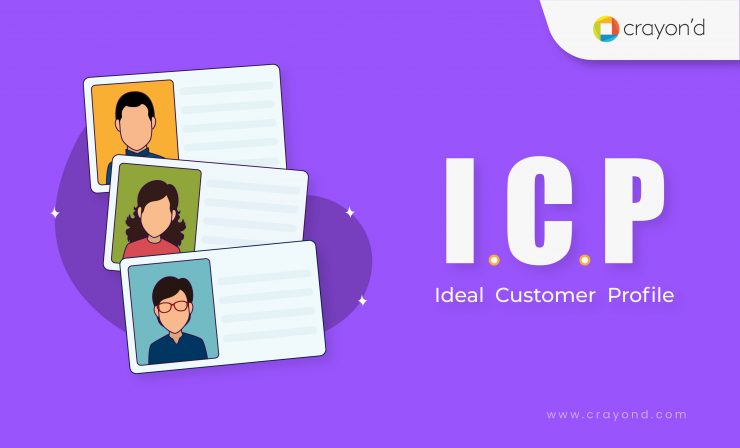With every step that you take to knowing your customers better, your business moves forward towards growth.
Customer knowledge is the cornerstone of every business initiative — from validating the product idea, incorporating the right features, to sustaining the business in the longer run.
What testifies your deeper customer knowledge?
It’s your ability to identify and recognize the people who fit right into the business. Well, count on the awareness of who isn’t the right fit.
It’s alright if you don’t know this yet. Ideal Customer Profile (ICP) is where you need to start. In this blog, we will see in detail the ICP and the steps to create one for your business.
Let’s get straight to the point!
What is an Ideal Customer Profile (ICP)?
Let’s first deal with the term ideal customer.
An ideal customer is one who immensely benefits from your offering. In return, they provide value to your business. While this is the primary criterion, there is more to add.
Ideal Customer Profile describes all the attributes that qualify people as your ‘ideal customer’. For B2C, it talks about the characteristics of a single imaginary user. For B2B, ICP depicts the type of company most likely to purchase your product.
It includes details like company size, location, revenue, niche/domain, etc. You derive these ideal traits/factors from the companies that usually,
- Have quicker and more successful sales cycles
- Have high customer retention rates
- Are your biggest advocates
ICP is where needs meet— customers that wish to have your product and customer you want to have, a two-way street. It informs your marketing and sales strategy and aligns both teams’ efforts towards high-value customers. Well, there’s more to it you will be getting to know.
Why is ICP important?
An ideal Customer Profile is very useful for account-based companies.
Focused marketing efforts
When your efforts are scattered and widespread, they may not yield the expected results.
Your campaign’s efforts might get too skewed toward unrelated demographics.
ICP lets you know which segment of people are more likely to convert. It narrows down your focus so that you can personalize your marketing campaigns.
Successful sales cycles
Often you’ll come across several leads interested in your product. However, not all will convert, bring value, and stay for long.
With ICP, you will be able to identify high-quality leads. It results in more successful sales cycles. Also, ICP saves the team’s time from weaker leads whose sales cycles take longer and might not convert
Increase Customer Lifetime Value
Customer Acquisition is always accompanied by higher costs. With ICP, you’ll know which customers need you the most. As a result, you don’t waste your efforts, time, and budget on some random account that will churn sooner.
Also, ICP helps you understand the customers better. It enables you to streamline and personalize the experience. These customers are more likely to stay associated with your product/service for a very lengthy period. Thereby, it results in increased customer lifetime value.
Such customers mostly become loyal advocates bringing you more clients. Hence, ICP lets you find the right fit for your business that’ll be helpful in the long term.
Improve Product-Market Fit
ICP is a key to deeper customer knowledge. What brings them to your product, what makes them buy, and what more they expect— you’ll gain an understanding about these. It gives you a glimpse of market landscapes and user needs.
ICP creates an opportunity to test your product-market fit. If there’s any gap, you can re-strategize the sales and marketing efforts. Your team can extract insights and apply them to tweak your product. Inputs from the market can aid in moving closer to product-market fit.
Steps to create your ICPs

1. Collect current customer data
Data is the primary requirement for developing your ICPs. Start with compiling data of your existing customers. Collect the list of companies who have bought your product/service. Ensure to get as much information as possible about those customers— their customer journey map, channels for approach, sales cycle, acquisition cost, etc.
If you are a new company, you will not have any existing customer data. In that case, you can focus on the problem you are solving. Identify the people who face the issue and are looking for solutions.
2. Identify your best customers
Now that you have the customers list, find your best customers. ‘Best customer’ is a relative term. It varies from one company to another. It’s upon you to define the qualifying factor for your business’ best clients. Some companies consider the stay duration (prolonged periods) or quicker conversions. Here are a few other factors to consider,
- High Net Promoter Score (NPS)
- High Annual Contract Value (ACV)
- High customer health score
- Higher profitability, etc.
The criteria for the best customer should be discussed and agreed upon with all the stakeholders and teams.
3. Find common attributes
After deciding the criteria, filter out your ideal customers. It’s time to spot the similarities between your best clients. Find the patterns in your customer data. It could be the organization size, revenue, location, industry type, etc.
These attributes are the building blocks for your ICP. Note down these in a spreadsheet for further reference.
4. Interview your customers
Connecting with your present customers can fill in the missing pieces of information. You can collect their input through surveys as well. In the case of interviews, it can happen in-person, or simply a Zoom call will be sufficient.
Talking to your customers will reveal answers to “What made them go for the purchase?” You can understand even more specifics like the company’s decision-makers, their pain points, reasons for their prolonged stay, etc.
You can also get their feedback about your service/product. It lets you know the features they consider valuable, the areas that need improvement, parts they don’t like, and much more.
5. Build profile using a template
You are equipped with all the details required for creating your ICP. Now, what’s left is putting all of these together. First, you need to define the traits for your ICP. It, again, varies for each business and is left to your choice.
ICPs can have 5-10 traits. Most usually ICPs comprises the following characteristics,
- Industry
- Geographic location
- Size of the organization
- Budget
- Decision-making factors & Decision Makers
- Organizational pain-points
- Revenue
- Technologies used (If there are commonly used technologies)
- Their customer base (If it matches)
Let’s deal with a basic example here. Consider you are an email marketing software company. Here goes your ICP,

There are a number of templates available for Ideal Customer Profile creation. You can use them if you find them good.
Remember: the market and users are dynamic. So you need to update your ICP regularly.
ICP vs Buyer personas
ICP is generally used by B2B companies. But, B2C companies can also find the ICPs to be beneficial. Let’s approach ICPs and buyer personas through the lens of B2B and B2C organizations.
B2B companies:
ICP stays at the organizational level and describes the company size, industry type, etc. It documents the attributes that qualify a company as your ideal client.
Buyer personas focus on the people in the organization who make the buying decisions. It elaborates on the buying individual’s psychological traits, challenges, goals, and demographic information.
Every company consists of different buyer personas who have differing purchase behaviors. While ICPs determine the decision-makers, buyer personas go a little further in understanding those decision-makers on a profound and personal level.
To sum up,
Zoom out view: Organizational focus-ICP
Zoom in view: Buyers inside the organization-Buyer persona
ICP informs WHOM to sell to, and buyer persona defines HOW to sell to them.
B2C Companies:
While B2B ICP focuses on firmographic details, the B2C companies’ ICP deals with the demographics of the individual users.
B2C buyer personas, unlike B2B, don’t focus on business as entry points. The buyer doesn’t have to be from a particular firm/company. B2C buyer personas focus on the aspects like that of B2B, only that company factor removed.
Let us look at an example of ICP and respective buyer personas. Say your business sells CRM software.

Endnote
Businesses cannot thrive by being generic.
You have to be specific —with the budget, domain, or even strategy. The same is the case with customers. Having a generic focus on the market will not bring you any users but loss.
Love Business needs reciprocation.
Your efforts need to be seen, validated, and recognized. And, only the right people can do it. Similarly, to understand the value of your product, they must have a need/pain point it addresses.
ICP tells you who the right people are, who you can spend your time and money on, and most importantly, who will value your efforts and who will be valuable for your business(in the long term).
In short, ICP helps you find customer-business relationships that reciprocate!
Aim for a perfect product. You will end up building something close to perfection.
Similarly, in search of a ‘perfect’ customer, you’ll get near-perfect ones. Well, near-perfect is not what you get through ICP. A level-up: it gives you the knowledge of finding the customers who are the right fit.
Is there any greater gift than this wisdom? Unwrap it and start utilizing ICPs.







Add comment